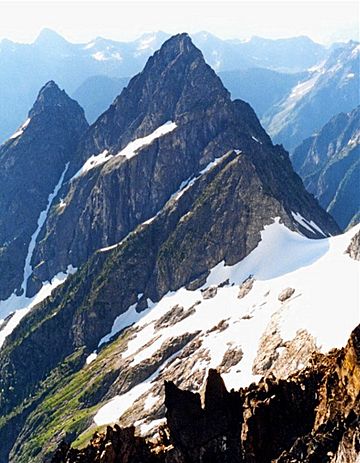Trapper Mountain facts for kids
Quick facts for kids Trapper Mountain |
|
|---|---|

Trapper Mountain seen from Magic Mountain
|
|
| Highest point | |
| Elevation | 7,530 ft (2,300 m) |
| Prominence | 1,170 ft (360 m) |
| Isolation | 0.92 mi (1.48 km) |
| Parent peak | Hurry-up Peak (7,821 ft) |
| Geography | |
| Location | Chelan County, Washington, U.S. |
| Parent range | North Cascades |
| Topo map | USGS Cascade Pass |
| Climbing | |
| First ascent | 1949, George Bell, Andrew Griscom, Harry King, W V Graham Matthews |
| Easiest route | class 3 scrambling |
Trapper Mountain is a tall mountain, about 7,530 feet (2,295 meters) high. It's located in Chelan County, in the state of Washington. It's part of the amazing North Cascades mountain range.
You can find Trapper Mountain southeast of Cascade Pass. It sits right on the edge of two special areas: North Cascades National Park and the Glacier Peak Wilderness. The closest mountain that's even taller is Hurry-up Peak, which is about 0.92 miles (1.48 kilometers) to the west. Rain and melting snow from the mountain flow into Trapper Lake and then into smaller streams that join the Stehekin River.
Mountain Weather
Trapper Mountain is in a place with a "marine west coast" climate. This means it gets a lot of influence from the ocean. Most of the weather systems start over the Pacific Ocean. They then travel northeast towards the Cascade Mountains.
As these weather systems get close to the North Cascades, the tall mountains force the air upward. This causes the air to cool down and drop its moisture. This moisture falls as rain or snowfall onto the Cascades. This process is called Orographic lift. Because of this, the western side of the North Cascades gets a lot of rain and snow, especially in winter.
During winter, the weather is usually cloudy. But in summer, high-pressure systems over the Pacific Ocean often bring clear skies. Because of the ocean's influence, the snow here tends to be wet and heavy. This can make avalanches more likely.
How the Mountains Formed
The North Cascades are known for their rugged look. They have sharp peaks, rocky ridges, deep valleys carved by glaciers, and tall, pointy granite rocks. The way these mountains look today is because of big geological events that happened millions of years ago. These events created huge changes in height across the Cascade Range. These changes also led to different climates and types of plants in various areas.
The story of the Cascade Mountains began millions of years ago, during the late Eocene Epoch. The North American Plate was slowly moving over the Pacific Plate. This movement caused many periods of volcanic activity. Also, small pieces of the Earth's crust, called terranes, came together to form the North Cascades about 50 million years ago.
Later, during the Pleistocene period (which started over two million years ago), glaciers grew and shrank many times. As they moved, these huge ice sheets scraped and shaped the land. They left behind piles of rock and debris. The "U"-shaped valleys you see today were formed by these glaciers. The combination of the land being pushed up (called uplift) and cracks in the Earth's crust (called faulting), along with the glaciers, created the tall peaks and deep valleys of the North Cascades.
Images for kids






